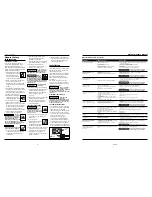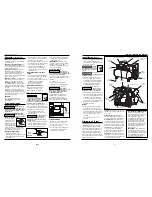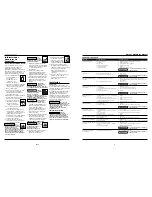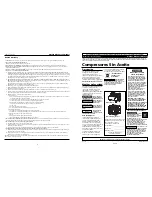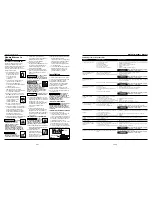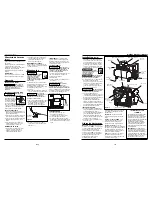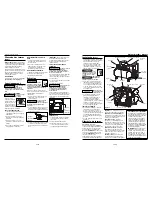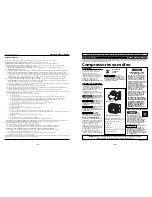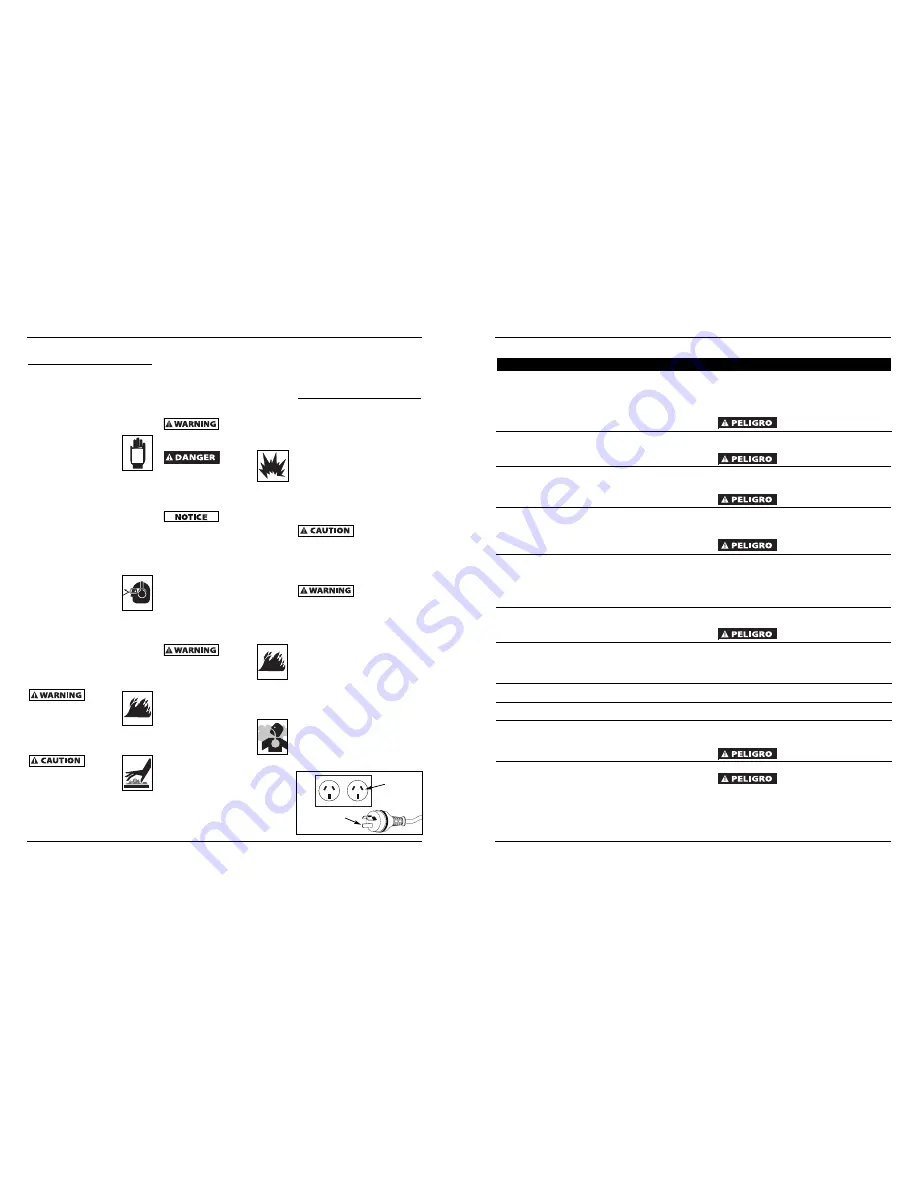
WX1001, WX2001 y WX8017
23 Sp
Guía de diagnóstico de averías
Problema
Posible(s) Causa(s)
Acción a tomar
1. No hay energía eléctrica
2. Fusible quemado
3. Cortacircuito desconectado
4. Protector de sobrecarga térmica disparado
5. Presostato dañado
6. La válvula de chequeo está dañada
1. Voltaje bajo
2. Defecto de la bobina del motor
3. Válvula de chequeo o desfogue defectuosa
1. Fusible inadecuado, circuito sobrecargado
2. Válvula de chequeo o desfogue defectuosa
1. Voltaje bajo
2. Filtro de aire está atascado
3. Poca ventilación/temperatura ambiental muy
alta
4. La válvula de chequeo está dañada
1. Hay alguna válvula con fugas, rota o floja o el
paso de aire está restringido
2. El sistema de desfogue del presostato está
dañado
3. Los cojinetes del excentrico o eje del motor
están dañados
4. El cilindro o anillo del pistón está desgastado o
rayado
5. Pernos flojos, tanque desnivelado
1. Conexiones flojas (conexiones, tuberías, etc.)
2. La llave de drenaje está floja
3. Hay una fuga en la válvula de chequeo
1. Orificio de entrada atascado
2. Hay fugas de aire en las tuberías (del compresor
o del sistema de conexión)
3. Las válvulas de entrada están dañadas
4. El anillo del pistón está dañado
5. El cilindro o anillo del pistón está desgastado o
rayado
1. Exceso de agua en el tanque
2. Humedad alta
1. El presostato está dañado
2. Consumo excesivo de aire
1. Condensación excesiva en el tanque
2. Hay fugas de aire en las tuberías (del compresor
o del sistema de conexión)
3. Fuga en la válvula de chequeo del tanque
La válvula de chequeo está atascada y no se puede
cerrar
1. ¿Está conectado? Chequée el fusible/cortacircuito o protector de
sobrecarga del motor
2. Reemplace el fusible quemado
3. Conéctelo, determine la causa del problema
4. Reposicionar el protector de sobrecarga térmica
5. Reemplácelo
6. Desconecte y reemplace la válvula de chequeo
Antes de desmantelar la válvula de
chequeo purgue el aire del tanque
1. Chequée las conecciones, chequée con un voltimetro
2. Reemplace el motor
3. Reemplácela o repárela
Antes de desmantelar la válvula de
chequeo purgue el aire del tanque
1. Cerciórese de que está usando el fusible adecuado, use un fusible de
acción retardada. Desconecte los otros artefactos eléctricos del
circuito o conecte el compresor a otro circuito
2. Reemplácela o repárela
Antes de desmantelar la válvula de
chequeo purgue el aire del tanque
1. Chequée con un voltimetro
2. Limpie el filtro (vea la sección de Mantenimiento)
3. Mueva el compresor a un área bien ventilada
4. Reemplácela
Antes de desmantelar la válvula de
chequeo purgue el aire del tanque
1. Reemplácela
2. Reemplácelo o repárelo según sea necesario
3. Reemplácelo
4. Reemplácelo o repárelo según sea necesario
5. Apriete los pernos, nivele el tanque con unas almohadillas
1. Chequée todas las conexiones con agua enjabonada y apriételas
2. Apriétela
3. Desmantele la válvula de chequeo, límpiela o reemplácela
Antes de desmantelar la válvula de
chequeo purgue el aire del tanque
1. Límpielo o reemplácelo
2. Reemplace las tuberías que tengan fugas o apriételas según sea
necessario
3. Un técnico especializado debe reparar el compresor
4. Reemplácelo
5. Reemplácelo
1. Drene el tanque
2. Mueva el compresor a una área menos húmeda; use un filtro de aire
incorporado a la línea
1. Reemplace el presostato
2. Disminuya el consumo de aire; el compresor es muy pequeño para
suministrar el aire requerido
1. Drénelo con más frecuencia
2. Reemplace las tuberías que tengan fugas o apriételas según sea
necessario
3. Reemplácela o repárela según sea necesario
Antes de desmantelar la válvula de
chequeo purgue el aire del tanque
Desconecte y reemplace la válvula de chequeo
Antes de desmantelar la válvula de
chequeo purgue el aire del tanque
El compressor no funciona
El motor hace ruido pero no
funciona o funciona
lentamente
Los fusibles se
queman/cortacircuito se activa
con frecuencia
El protector de sobrecarga
térmica se activa
constantemente
Golpea, hace ruido, vibración
excesiva
La presión del tanque baja
cuando el compresor se apaga
La salida de aire es inferior a la
normal/la presión de salida es
baja
Exceseso de humedad en el aire
expulsado
El compresor funciona
continuamente
El compresor se enciende y se
apaga automáticamente con
mucha frecueneia
Hay una fuga de aire en el
sistema de desfogue del
presostato
17. When spraying or cleaning with
solvents or toxic chemicals, follow
the instructions provided by the
chemical manufacturer.
Installation
LOCATION
The tank must sit level or slope slightly
towards the drain valve to allow the
tank to drain properly.
It is extremely important to install the
compressor in a clean, well ventilated
area where the surrounding air
temperature will not be more than
104°F (40°C).
A minimum clearance of 4 inches
(10.16 cm) between the compressor
and a wall is required because objects
could obstruct air flow.
Do not locate the
compressor air
inlet near steam, paint spray, sandblast
areas or any other source of
contamination. This debris will damage
the motor.
ELECTRICAL INSTALLATION
All wiring and
electrical
connections should be performed by a
qualified electrician. Installation must
be in accordance with local codes and
national electrical codes.
GROUNDING INSTRUCTIONS
1. This product is for use on a nominal
240 volt circuit and has a grounding
plug that looks like the plug
illustrated in Figure 1. Make sure the
product is connected to an outlet
having the same configuration as the
plug. This product must be
grounded. In the event of an
electrical short circuit, grounding
reduces risk of electrical shock by
providing an escape wire for electric
current. This product is equipped
with a cord having a grounding wire
with an appropriate grounding plug.
General Safety
Information
OPERATIONAL SAFETY
Since the air compressor and other
components (material pump, spray
guns, filters, lubricators, hoses, etc.)
used, make up a high pressure pumping
system, the following safety precautions
must be observed at all times:
1. Read all manuals included
with this product carefully.
Be thoroughly familiar
with the controls and the
proper use of the equipment.
2. Follow all local electrical and safety
codes, as well as in the U.S.A.,
National Electrical Codes (NEC) and
Occupational Safety and Health Act
(OSHA).
3. Only persons well acquainted with
these rules of safe operation should
be allowed to use the compressor.
4. Keep visitors away and NEVER allow
children in the work area.
5. Wear safety glasses and use
hearing protection when
operating the pump or unit.
6. Do not stand on or use the
pump or unit as a handhold.
7. Before each use, inspect compressed
air system and electrical components
for signs of damage, deterioration,
weakness or leakage. Repair or
replace defective items before using.
8. Check all fasteners at frequent
intervals for proper tightness.
Motors,
electrical
equipment and controls can
cause electrical arcs that will
ignite a flammable gas or
vapor. Never operate or repair
in or near a flammable gas or vapor.
Never store flammable liquids or gases
in the vicinity of the compressor.
Compressor parts may be hot
even if the unit is stopped.
9. Keep fingers away from a
running compressor; fast moving
and hot parts will cause injury
and/or burns.
2
Oilless Compressors
10. If the equipment should start to
abnormally vibrate, STOP the
engine/motor and check
immediately for the cause. Vibration
is generally a warning of trouble.
11. To reduce fire hazard, keep
engine/motor exterior free of oil,
solvent, or excessive grease.
Never remove or
attempt to adjust
safety valve. Keep safety valve free
from paint and other accumulations.
Never
attempt
to repair or modify a tank!
Welding, drilling or any other
modification will weaken the
tank resulting in damage from rupture
or explosion. Always replace worn or
damaged tanks.
Drain liquid from
tank daily.
12. Tanks rust from moisture build-up,
which weakens the tank. Make sure
to drain tank daily and inspect
periodically for unsafe conditions
such as rust formation and
corrosion.
13. Fast moving air will stir up dust and
debris which may be harmful.
Release air slowly when draining
moisture or depressurizing the
compressor system.
SPRAYING PRECAUTIONS
Do not
spray
flammable materials in
vicinity of open flame or near
ignition sources including the
compressor unit.
14. Do not smoke when spraying paint,
insecticides, or other flammable
substances.
15. Use a face mask /
respirator when spraying
and spray in a well
ventilated area to prevent
health and fire hazards.
16. Do not direct paint or other sprayed
material at the compressor. Locate
compressor as far away from the
spraying area as possible to
minimize overspray accumulation
on the compressor.
Grounded
Outlet
Grounded Pin
Figure 1
MANUAL


